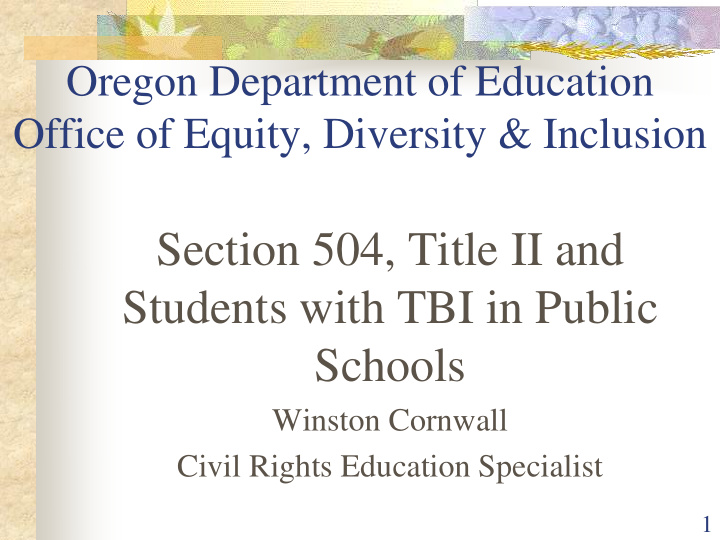



Oregon Department of Education Office of Equity, Diversity & Inclusion Section 504, Title II and Students with TBI in Public Schools Winston Cornwall Civil Rights Education Specialist 1
Today’s Objectives Discuss the requirements of Section 504 of the Rehabilitation Act and Title II of the Americans with Disabilities Act Explain the responsibilities of public schools in educating students with disabilities (TBI) 2
Keys in Today’s 504/Title II OCR: 504 is a general education responsibility Goal is to make the environment more accessible 504 Team member knowledge/contribution No single source decides in any aspect Timely and effective accommodations Episodic and “in remission” in play No mitigating measures (except?) 3 3
Which Schools are Covered by 504 and Title II? Section 504 prohibits discrimination on the basis of disability by schools that receive Federal financial assistance Title II prohibits discrimination against people with disabilities by public schools (including public vocational schools and public charter schools) 4
Section 504 and Title II What do school districts need to know? 5
Locate and Notify Every year, each district must: Identify and locate students with disabilities in the district who are not receiving a public education Notify parents/guardians of children with disabilities of the district’s duties under Section 504 6
Provide a Free Appropriate Public Education to each qualified student with a disability in the school district’s jurisdiction regardless of the nature or severity of the disability 7
What does “free and appropriate” mean? Free means free! not charging for costs related to disability may charge usual fees paid by all students Appropriate: regular or special education and related aids and services designed to meet a student's individual needs as adequately as the needs of non-disabled persons are met 8
The Process Identification Evaluation Placement
Identify and Evaluate Districts must individually evaluate any child who, because of a disability, needs or is believed to need accommodations or related services 10
Purpose of the Evaluation The evaluation is intended to answer two questions: (1) Does the child have a disability under Section 504/Title II? If so: (2) What are the child’s individual education needs? 11
Question #1: Does the child have a disability? i.e., does the student have a physical or mental impairment which substantially limits one or more major life activities? 12
What is an Impairment? Any physiological condition that affects a bodily system, or any mental or psychological disorder 13
Does the student’s impairment substantially limit one or more major life activities? 14
Major Life Activities include (but are not limited to): Eating Caring for oneself Sleeping Performing manual tasks Standing Walking Lifting Seeing Bending Hearing Reading Concentrating Speaking Thinking Breathing Communicating Learning Interacting with Others Working 15
Major Life Activities (cont.) Major life activities also include operation of “major bodily functions” such as: Brain Functions of the immune system Circulatory Normal cell growth Endocrine Digestive Reproductive Bowel Functions Neurological Bladder Respiratory 16
Substantial Limitation Does not mean severe restriction or inability in performing major life activity Look to condition, manner, duration 17
Question #2: What are the child’s individual education needs? Needs are identified by looking to a variety of evaluation sources, including: aptitude and achievement tests teacher recommendations physical condition social or cultural background adaptive behavior 18
The student has been evaluated Eligibility has been established Her/His needs have been identified Next, decide on . . . 19 19
PLACEMENT 20
Placement Appropriate educational services designed to meet the student’s individual needs 21 21
Who Decides? The “team” -- a group that includes persons knowledgeable about: the student the meaning of the evaluation data the placement options 22 22
Placement Procedures The Team carefully considers: evaluation information from a variety of sources all significant factors affecting the student’s ability to receive a FAPE 23 23
Placement Procedures cont’d The Team: documents all the information considered does not rely on assumptions regarding persons with disabilities or classes of such persons IT’S ABOUT THE INDIVIDUAL! 24 24
504 Accommodations (cbirt.org) Processing delays Memory deficits Visual Spatial Deficits Fine Motor Difficulties Gross Motor Difficulties Mobility Fatigue 25
504 Accommodations (cbirt.org) Attention Organizational Skills Academic Progress Emotional Wellbeing Behavior Transitions Technology 26
Types of Academic Settings Regular classes Regular classes with supplementary services, and/or Special education and related services 27 27
Once educational placement has been decided . . . Implement the plan! 28 28
Re-Evaluation – When? Periodically Before a significant change in placement 29
Procedural Safeguards School districts must provide a system of procedural safeguards regarding identification, evaluation, and educational placement 30 30
Procedural safeguards include: Notice Records review by parent or guardian Due process -- impartial hearing with participation by parent and counsel A review procedure 31 31
FAPE - Common Compliance Concerns Making decisions unilaterally instead of by Team Making decisions that are not based on evaluation information or child’s needs Failing to implement 504 Plan Not affording parents procedural safeguards 32 32
Other Responsibilities 33
Extracurricular activities Students with disabilities must be provided an equal opportunity to participate in transportation, lunch, recess, physical education, clubs, athletics, etc. May be part of 504 Plan 34 34
Discrimination under 504/Title II Denial of FAPE is only one form OTHERS: Different treatment/impact Disability harassment “Significant assistance” to an entity that discriminates Any exclusion, denial of benefit, or other form of discrimination 35 35
For Further Assistance: Contact Winston Cornwall: (503) 947-5675 (voice) (503) 378-5156 (fax) Winston.cornwall@state.or.us (email) www.ode.state.or.us (web) 36 36
Recommend
More recommend